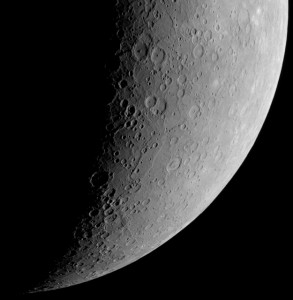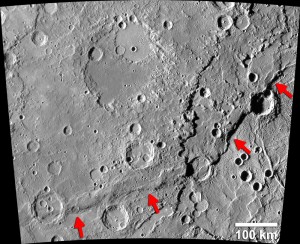29 May 2015
A shrinking Mercury is contracting in unexpected ways
Posted by Nanci Bompey
By Alison Mitchell and Amy Stamm

This limb view of the south polar region of Mercury was taken by the Wide Angle Camera of the Mercury Dual Imaging System (MDIS) on the MESSENGER spacecraft while it was in orbit. The long, cliff-like landforms are lobate thrust fault scarps caused by the contraction of the planet and include Terror Rupes and Eltanin Rupes, the pair of scarps near the center.
Credit: NASA/Johns Hopkins University Applied Physics Laboratory/Carnegie Institution of Washington/Smithsonian Institution
Images obtained during the MErcury Surface, Space ENvironment, GEochemistry and Ranging (MESSENGER) spacecraft’s more than four years in orbit have revealed a vast array of large thrust-fault scarps, or cliffs, that are evidence that Mercury has experienced significant planetary contraction.
A global survey of the largest, most prominent fault scarps has revealed some unexpected wrinkles in the way Mercury has contracted. The findings are reported in a new study that has been accepted for publication in Geophysical Research Letters, a journal of the American Geophysical Union.
The scarps look like giant stair-steps in the landscape and are formed when crust materials are pushed together, break and are thrust upward along the fault. The scarps the study’s authors studied are up to hundreds of kilometers long and more than a kilometer high. The most widely accepted model of the origin of the fault scarps is global contraction resulting from cooling of Mercury’s still-hot interior. Based on this model, global contraction should generate a planetwide array of thrust faults that are uniformly distributed on the surface, with no particular pattern in the orientations of the faults.
The new research contradicts this model: MESSENGER has found distinct patterns in the orientations of the fault scarps and clear concentrations in the number of scarps. Many scarps are concentrated in two broad longitudinal bands.
Even more surprising is that the majority of the largest fault scarps, those with lengths greater than a hundred kilometers, are found in one hemisphere of Mercury. “There are almost three times more large faults in the southern hemisphere than in the northern hemisphere. This is pretty lopsided and not what you’d expect from a uniformly contracting body,” said lead author Thomas Watters, senior scientist at the Center for Earth and Planetary Studies at the Smithsonian’s National Air and Space Museum. “The pattern in orientations and the hemispheric dichotomy in the number of large faults suggest we’re missing something.”

Enterprise Rupes is the largest lobate fault scarp found on Mercury at about 1000 km long and is over 3 km high. This giant thrust fault scarp was formed when crustal materials were pushed together, broke and were thrust upward along the fault. Enterprise Rupes crosscuts the rim and floor of the Rembrandt basin, one of the largest impact basins on Mercury. Red arrows show the location of the Enterprise Rupes.
Credit: NASA/Johns Hopkins University Applied Physics Laboratory/Carnegie Institution of Washington/Smithsonian Institution
The paper points to several factors that may be responsible for the non-random orientations of the faults. Contraction of the planet due to interior cooling in combination with slowing of its early rapid rotation rate, along with possible surface temperature-induced thinning of Mercury’s lithosphere (the brittle outer part of the planet) from equator-to-pole, could explain the orientations of the fault scarps. One possible explanation for the uneven concentration of the fault scarps is the influence of mantle (the rocky layer between the core and the crust) flow on the planet. On Mercury, the mantle is very thin, and its flow and the scale of convection cells (flow of raising warm material and sinking cold material) are much more restricted. Earth’s mantle flow and convection drive the motion of a mosaic of lithospheric plates and localize most of the major faults at their boundaries.
“There’s still a lot to learn about the forces that created the vast array of large fault scarps on Mercury,” Watters said. “Mercury, in contrast to Earth with its multiple plates, is the ideal place to investigate how single-plate planets shrink and deform. Understanding Mercury is essential to explaining how planets evolve in our solar system and how they likely evolve in other planetary systems in the galaxy.”
On April 30, the MESSENGER spacecraft’s mission ended with a planned impact on the surface of Mercury. MESSENGER was launched Aug. 3, 2004, and began orbiting Mercury March 17, 2011. Although it completed its primary science objectives by March 2012, the spacecraft’s mission was extended two times.
The Center for Earth and Planetary Studies is the scientific research unit within the Smithsonian’s National Air and Space Museum. Its scientists perform original research and outreach activities on topics covering planetary science, terrestrial geophysics and the remote sensing of environmental change.
— Alison Mitchell and Amy Stamm are public affairs specialists at the Smithsonian’s National Air and Space Museum. This post originally appeared as a press release on the museum’s website.


 GeoSpace is a blog on Earth and space science, managed by AGU’s Public Information staff. The blog features posts by AGU writers and guest contributors on all sorts of relevant science topics, but with a focus on new research and geo and space sciences-related stories that are currently in the news.
GeoSpace is a blog on Earth and space science, managed by AGU’s Public Information staff. The blog features posts by AGU writers and guest contributors on all sorts of relevant science topics, but with a focus on new research and geo and space sciences-related stories that are currently in the news.